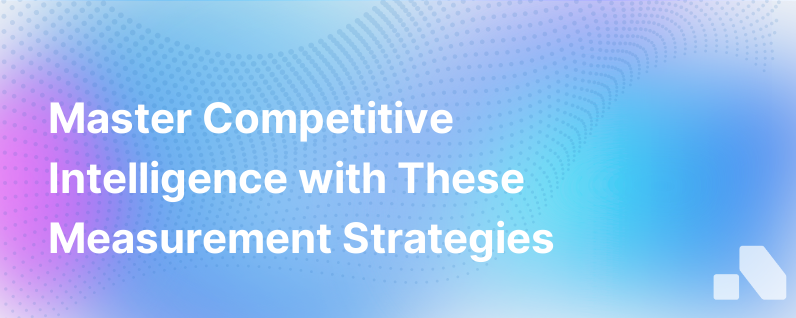
Understanding, assessing, and responding to your competition is an integral part of any successful business strategy. However, in today's dynamic business landscape, keeping track of competitor moves can be an arduous task. This is where competitive intelligence steps into play. But, what good is competitive intelligence if it can't be measured effectively? In this guide, we'll look at how to start measuring competitive intelligence, and use it as an essential tool to sharpen your competitive edge.
Understanding Competitive Intelligence
Competitive Intelligence (CI) is the act of gathering, analyzing, and using information about your competitive environment to support decision making and strategic planning. It is about understanding and learning everything there is to know about the world outside your business so you can be as competitive as possible. This includes understanding your competitors, market dynamics, customer preferences, and all the other drivers that influence your success.
The Necessity of Measuring CI
Despite its importance, competitive intelligence is often underutilized because it’s seen as hard to quantify. However, Competitive Intelligence's effectiveness revolves around its measurability with metrics tailored to the information being gathered. As the adage goes, “what gets measured, gets managed.”
Implementing effective competitive intelligence measurement procedures helps your organization:
- Optimise marketing and sales strategies
- Discover new market opportunities and threats
- Benchmark your performance against competitors
- Generate and justify strategic decisions
Key Metrics for Measuring CI
Before we dive into the specifics of measuring competitive intelligence, let's get a brief overview of the key Generic metrics exist that can provide a framework for shaping your intelligence strategy. Some of these include:
Market Share: As a top-line metric, market share is the most straightforward measurement of how your company stacks up against competitors.
Brand Perception: One of the hardest, but most important, things to quantify is brand effect. This includes customer awareness, associations, loyalty, and overall sentiment.
Product Comparison: Assessing your products against those of competitors in areas like features, quality, pricing, and customer reviews can ground your market positioning.
Step-by-Step Guide to Start Measuring CI
Now that you have an understanding of what competitive intelligence entails, the next step is to start measuring it. Here's a step-by-step guide to help you navigate:
Step 1: Define Objectives
The first step in measuring CI is to clearly outline your objectives. What specific business questions are you aiming to answer with your CI program? Answering this will help guide your intelligence gathering and analysis strategy.
Step 2: Identify Competitors
Identifying both direct and indirect competition is crucial. Direct competitors offer similar products or services, while indirect competitors may offer different products but compete for the same customer dollars.
Step 3: Data Gathering
Once you’ve identified your competitors, the next step is to start gathering data. This could include their product range, pricing strategies, SWOT analysis, social media trends and consumer reviews.
Step 4: CI Analysis
After data is collected, it’s time to analyze. Compare the data to your own brand’s performance to gain insights. Tools like Aomni can help you synthesize this data into actionable insights.
Step 5: Set your Benchmark
Based on the analysis, identify the gaps, set your benchmarks and KPIs based on the performance of the leaders in your industry.
Step 6: Monitor and Report
CI is not a one-time process. Regularly monitor your competitors' moves, track your progress against the set benchmarks and report the insights to the relevant stakeholders to make informed strategic decisions.
Leveraging Technology for CI Measurement
Today, there are plenty of competitive intelligence tools that enable businesses to efficiently track, analyze, and measure competitive data. Aomni, for instance, is an AI-powered platform that simplifies the CI measurement process. It provides real-time insights and personalized sales content by processing large volumes of data, making CI activities more efficient and scalable.
To sum things up, competitive intelligence is crucial for a company to grow and succeed — you need to understand your competitors to effectively differentiate yourself, unearth untapped opportunities and develop successful strategies. Monitoring these aspects and setting up an infrastructure to measure and action these insights can lead to unparalleled business growth and greater competitive advantage in the market.